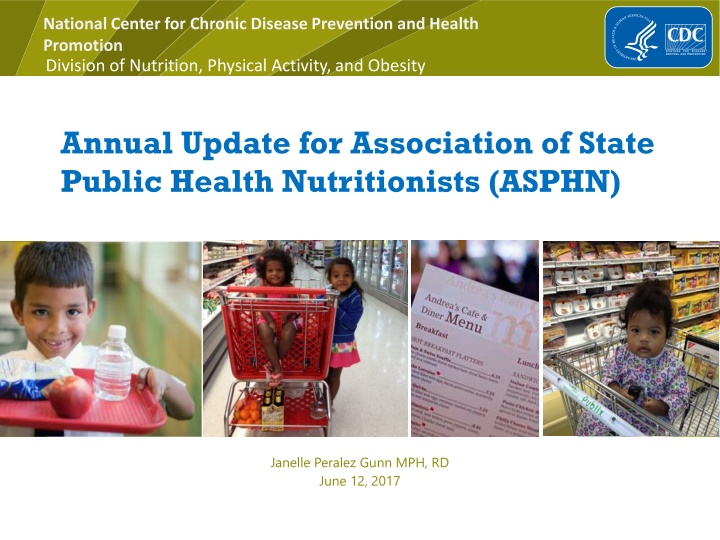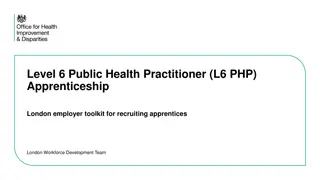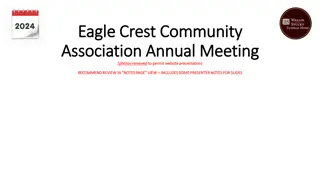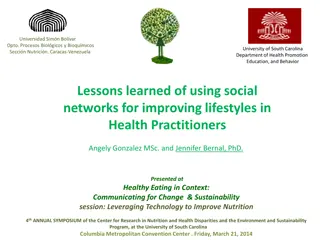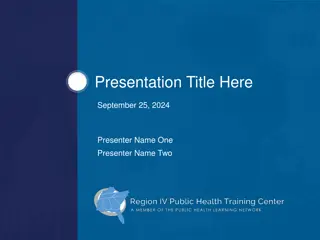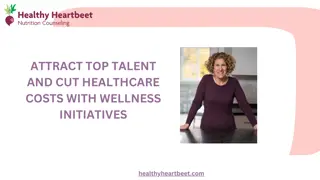Annual Update for Association of State Public Health Nutritionists (ASPHN)
National Center for Chronic Disease Prevention and Health Promotion focuses on protecting Americans' health by promoting physical activity and good nutrition. Chronic diseases are prevalent, costly, and preventable, being among the leading causes of death in the US. The Division of Nutrition, Physical Activity, and Obesity (DNPAO) plays a crucial role in combating chronic diseases throughout various life stages. The DNPAO's strategic priorities include promoting healthy early childhood practices, such as breastfeeding and education, to prevent conditions like obesity and malnutrition. By emphasizing healthy food environments, physical activity, and community design, the DNPAO aims to foster a healthier nation.
Download Presentation

Please find below an Image/Link to download the presentation.
The content on the website is provided AS IS for your information and personal use only. It may not be sold, licensed, or shared on other websites without obtaining consent from the author.If you encounter any issues during the download, it is possible that the publisher has removed the file from their server.
You are allowed to download the files provided on this website for personal or commercial use, subject to the condition that they are used lawfully. All files are the property of their respective owners.
The content on the website is provided AS IS for your information and personal use only. It may not be sold, licensed, or shared on other websites without obtaining consent from the author.
E N D
Presentation Transcript
National Center for Chronic Disease Prevention and Health Promotion Division of Nutrition, Physical Activity, and Obesity Annual Update for Association of State Public Health Nutritionists (ASPHN) Janelle Peralez Gunn MPH, RD June 12, 2017
DNPAOs Role in Your Health Protect the health of Americans at every stage of life by encouraging regular physical activity and good nutrition Work with partners to make the healthy choice the easy choice
Chronic Disease at CDC National Center for Chronic Disease Prevention & Health Promotion Heart Disease & Stroke Prevention Cancer Prevention and Control Diabetes Translation Nutrition, Physical Activity, & Obesity Smoking and Health Oral Health Population Health Reproductive Health
Keeping Americans Healthy at Every Stage of Life Chronic Diseases Are Common, Costly, and Preventable 7of the TOP10 leading causes of death in the US are due to chronic diseases. Not eating a healthy diet or getting enough physical activity increases a person s chance of getting a chronic disease. $147 BILLION US spends year. on obesity-related health care costs each $117 BILLION INADEQUATE PHYSICAL ACTIVITY. in annual health care costs are associated with
Division of Nutrition, Physical Activity, and Obesity (DNPAO) Ann O Connor Deputy Director Ruth Petersen Director Office of the Associate Director for Science Office of Policy, Partnerships, and Communications Program Resources Management Team Management Official Glynis Lash Administrative Officer Deborah Galuska Associate Director for Science Janelle Gunn Paulette Murphy Acting Management Official Associate Director for Policy Obesity Prevention and Control Branch Physical Activity and Health Branch Program Development and Evaluation Branch Nutrition Branch Capt. Heidi Blanck Branch Chief Janet Fulton Branch Chief Terry O Toole Branch Chief (Acting) Rafael (Rafa) Flores-Ayala Branch Chief
DNPAO Strategic Priorities Healthy Early Childhood Breastfeeding Early Care and Education Early Child Nutrition Vitamin & Mineral Malnutrition Childhood Obesity Management Healthy Food Environment Food Service Guidelines Behavioral Design Financial Incentive Programs Physical Activity Active People, Healthy Nation - National Walking Movement Community Design
DNPAO Budget History FY 2013-2017 FY13 FY14 FY 15 FY 16 FY 17 Budget Activity/Description Nutrition, PA, and Obesity - BA Final CA Final CA Final Final Enacted $41,052* $5,085 $12,585 $49,920 $49,920 High Obesity Counties $0 $4,986 (non-add) $7,500 (non-add) $10,000 (non-add) $10,000 (non-add) REACH (BA and PPHF) Red years not added to DNPAO total Nutrition, PA and Obesity (PPHF) $14,204 $50,950 $50,950 $50,950 $34,950 $0 $35,000 $35,000 $0 $0 National Early Childcare Collaborative (PPHF) $4,000 $4,000 $4,000 $4,000 $4,000 Hospital Promoting BF (PPHF) $2,500 $8,000 $8,000 $8,000 $8,000 Total (BA + PPHF) $47,552 $52,085 $59,585 $61,920 $96,870 FY 2017 Budget includes REACH, which was not a part of DNPAO in previous fiscal years * Includes 5% sequestration Does not include CORD Source: FY 2015-FY 2018 CDC Congressional Justifications, FY 2012-2017 Operating Plans
Program Investments $ $ $ $ $ Program to Reduce Obesity in High Obesity Areas (1416/1613) A Comprehensive Approach to Good Health and Wellness in Indian Country (1421) Childhood Obesity Research Demonstration Project (CORD) and CORD 2.0 (007/004) State Public Health Actions (1305) Racial and Ethnic Approaches to Community Health (REACH) (1419) Division of Nutrition, Physical Activity, and Obesity
DNPAOs Physical Activity Investments to States and Communities DNPAO PA Funding* Minimal (1-2 sources of funding) Modest (3 sources of funding) Adequate (4 sources of funding) *Funding from State Public Health Actions (1305), High Obesity (1416), REACH (1419), and State and Local Public Health Actions (1422)
Racial and Ethnic Approaches to Community Health (REACH) Program administered by the CDC to reduce racial and ethnic health disparities Awardee partners plan and carry out local, culturally appropriate programs to address a wide range of health issues Funds awarded to state and local health departments, tribes, universities, and community-based organizations Awardees use these funds to build strong partnerships to guide and support the program s work Along with funding, CDC provides expert support to REACH awardees.
DNPAO Strategic Priorities Healthy Early Childhood Breastfeeding Early Care and Education Early Child Nutrition Vitamin & Mineral Malnutrition Childhood Obesity Management Healthy Food Environment Food Service Guidelines Behavioral Design Financial Incentive Programs Physical Activity Active People, Healthy Nation - National Walking Movement Community Design
CDCs Three Strategies to Support Breastfeeding 2 1 3 Improve Hospital Support for Breastfeeding Improve Community Support for Breastfeeding Improve Support for Employed Women Our Goal Ensure that when a mom wants to breastfeed, she has the supports in place to successfully initiate and meet her goals
Our Progress to Support Mothers Has Remained Constant Surgeon General s Call to Action to Support Breastfeeding CDC Guide to Breastfeeding Interventions The CDC Guide to Strategies to Support Breastfeeding Mothers and Babies CDC advised to monitor maternity practices HHS Blueprint for Action on Breastfeeding 1st 2nd 3rd 4th 5th mPINC Survey mPINC Survey mPINC Survey mPINC Survey mPINC Survey 2000 2003 2005 2007 2009 2011 2013 2015 2004 2010 2012 Best Fed Beginnings (2011-2015) 2014 EMPower Breastfeeding (2014-2017) Healthy People 2020 Baby-Friendly measure introduced mPINC planning begins
Data for Action: Research & Surveillance Infant Feeding Practices Study II and Year 6 Follow- Up (2005-2007, 2012) SummerStyles (formerly HealthStyles) (from 1999) National Immunization Survey (from 2001) mPINC (from 2007) Provides information on health-related opinions of people 18 yrs and older, across the U.S. National and state estimates From 3rd trimester through 1st year of life Census of all birthing facilities Initiation, duration, exclusivity Public attitudes and beliefs about breastfeeding Assess Re-contacted at 6 years of age maternity care practices Demographic characteristics
mPINC CDC Survey of Maternity Practices in Infant Nutrition and Care Total mPINC Score, by state, 2015 Paving the Way to Improved Performance Nationwide DC Puerto Rico Island Territories (American Samoa, Guam, Saipan, and the U.S. Virgin Islands) > 90 80 - 89 70 - 79 < 70 National average: 79 Range: 60-96 Comprehensive frequency tables by state & facility type at www.cdc.gov/mpinc
Breastfeeding Breastfeeding Highlights 2016 Breastfeeding Report Card National Immunization Survey breastfeeding rates from birth year 2013 18% of births in Baby-Friendly hospitals mPINC 2015 Individual reports for ~2,500 participating hospitals State/Territory reports
Early Child Nutrition Held expert panel to develop logic model Promotion and Partners: Establishing and strengthening partnerships Conducted national webinar on early child nutrition with 1,000 Days Research: Developed research agenda to identify and address data gaps Published articles on key issues of early child nutrition Funded contractor to assess feasibility of conducting a longitudinal study of pregnant women & young children Education and training: Funded AAP to develop a continuing medical education module and a web portal to compile existing resources on early child nutrition
Early Care and Education Healthy Kids Healthy Futures 2nd Summit Feb 2016 Learning Collaboratives project in 10 states with Nemours 7 state mini-Collaborative Improvement & Innovation Network with ASPHN Record number of technical assistance & training activities with 1305 Go NAP SACC Annual update of state child care licensing regulation changes Completed DNPAO s first Early Care and Education State Indicator Report: https://www.cdc.gov/obesity/strategies/ece -state-indicator-report.html
Nutrition: Healthy Food Environment New Food Service Guidelines (FSG) for Federal Facilities Released January 2017 Voluntary best business practices that can be used to increase healthy and safe food options for employees Adoption & Implementation of FSG Technical assistance & Networking Calls National Network of Public Health Institutes Case Studies Community-Based Healthy Eating Survey Manuscripts FSG Collaborative Supply of Healthy Foods FSG, food bank & retail store sharing among partners Supported workgroups within the Nutrition and Obesity Policy Research and Evaluation Network Consumer Demand Increased Salad Bars to >4,900 schools (2.4 million students) Launched FITWEL National Collaborative on Childhood Obesity Research (NCCOR) Behavioral Design Workshop
Healthy Food Environment Increase adoption & implementation of Food Service Guidelines Develop behavioral design guidance to drive consumer demand for healthy food Expand evidence base on promising practices to increase the availability of healthier food and beverages and increase healthier purchases, especially among low- income consumers
Obesity Healthcare Highlights Increase uptake and payment of recommended healthcare prevention services Completed Childhood Obesity Research Demonstration (CORD) 1.0 Projects in CA, TX, MA for low-income children aged 2-12 Funded 2 new grantees for CORD 2.0 in MA, AZ Focus on youth obesity behavioral management programs Partner engagement includes: Strategies To Overcome and Prevent Obesity Alliance, Childhood Obesity Prevention and Treatment, Nemours/Robert Wood Johnson Foundation NCCOR: Community Clinical Linkages Workgroup Childhood obesity community clinical linkages workshop Electronic Health Records technology platforms to support healthy weight and behaviors
Vitamin & Mineral Malnutrition Provided technical assistance to 13 Surveys in 9 countries: 4 mass food fortification coverage surveys in South Africa, Uganda, Nigeria & Tanzania 3 national micronutrient surveys in Nepal, India & Malawi 3 micronutrient powder impact evaluation surveys in Uganda & Nepal 1 nutrition surveillance system in Guatemala
Physical Activity Strategies That Work Guide to Community Preventive Services. Physical Activity: Built Environment Approaches Combining Transportation System Interventions with Land Use and Environmental Design. https://www.thecommunityguide.org/findings/physical-activity-built-environment-approaches. Page last updated: May 01, 2017. Page accessed: May 4, 2017
Both obesity and low levels of physical fitness increase the risk for injury among active military personnel Nearly 1 in 4 young adults are too heavy to serve in our military Obesity has risen 61% among active duty service members Inadequate Physical Activity Impacts Our National Security and Military Readiness
Physical Activity Partners Active People, Healthy Nation is a national initiative led by CDC and coordinated with national partners
New Infographics Website: https://www.cdc.gov/physicalactivity/resources/factsheets.html
Community Health Online Resource Center (CHORC) Searchable database that is available to the public and provides users with resource to support program development, implementation, & evaluation Populated with practice-based resources to help you implement changes to prevent disease and promote healthy living in your community. Includes webinars, model policies, toolkits, guides, fact sheets, and other practical materials Updated quarterly Examples: 1. 2. 2015-2020 Dietary Guidelines for Americans Toolkit from the Robert Wood Johnson Foundation: A New Way to Talk about Social Determinants of Health CHORC website: https://www.cdc.gov/nccdphp/dch/online-resource/index.htm
Success Stories Made Easier Benefits of NCCDPHP Success Story Online Application: User friendly tool that ensures consistent messaging Online application asks a series of questions to breakdown your story into manageable pieces and provides quick tips and writing samples Step by step model that guides you through the process This tool helps the user explain what we do, why we do it, and how it is effective Choice of professionally designed templates and royalty free photos to create polished documents without incurring the time or expense of a designer https://nccd.cdc.gov/nccdsuccessstories/default.aspx
Data, Trends and Maps An interactive database that provides information about the health status and behaviors of Americans, state-by-state, via clickable maps, charts, and tables. Percent of adults who report consuming fruit less than one time daily View by: Total, 2015 Website:: https://www.cdc.gov/nccdphp/dnpao/data-trends-maps/index.html
Coming This Year Continued acceleration of priorities, including enhancing maternity practices in US hospitals Planning for the next round of extramural funding Continue to focus on primary and secondary prevention across the lifespan by supporting technical assistance for complex issues
Thank You! www.cdc.gov/breastfeeding For more information: www.cdc.gov/breastfeeding The findings and conclusions in this report are those of the authors and do not necessarily represent the official position of the Centers for Disease Control and Prevention.
